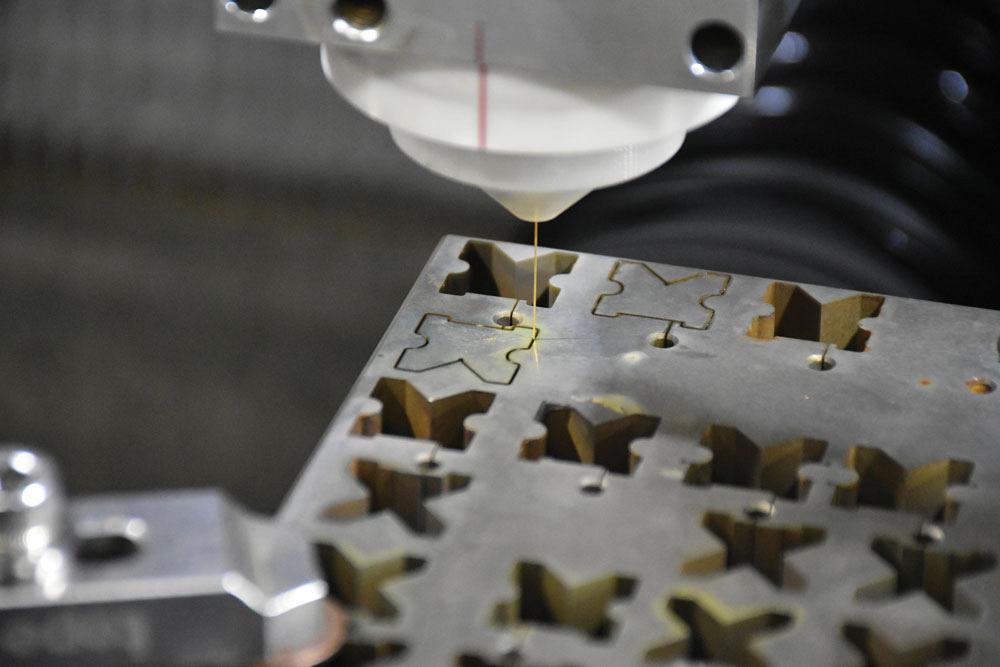Unveiling Electrical Discharge Machining (EDM): Revolutionizing Precision Machining for Complex Tasks
Electrical Discharge Machining (EDM) stands as a groundbreaking nonconventional machining process designed to tackle challenges beyond the reach of conventional methods. Employing electricity to meticulously erode the surfaces of conductive materials, EDM achieves remarkable precision without any physical contact between the tool and the workpiece. This unique attribute allows EDM to maintain exceptionally fine surface finishes, even on intricate and delicate components. The method encompasses die, wire, and drilling subtypes, with diverse applications ranging from creating turbine and compressor discs to crafting hip and knee implants, pacemakers, die molds, and microelectronics.
Join us in exploring the intricacies of EDM—how it operates, its distinct varieties, and its tangible impact on real-world applications.
What Is Electrical Discharge Machining?
Electrical Discharge Machining (EDM), commonly known as Spark machining. Electrical Discharge Machining (EDM), presents a compelling alternative to traditional machining methods by utilizing thermal forces instead of mechanical ones to eliminate material. The process involves the precise removal of material from the workpiece through the application of a high-temperature electrical spark. EDM is exclusively effective on electrically conductive materials like brass, aluminum, and steel.
The groundbreaking concept of exploiting electricity for erosive purposes dates back to 1770 when Joseph Priestly made this discovery. However, it wasn’t until 1943 that EDM, in its modern form, was invented. Soviet scientists B. Lazarenko and N. Lazarenko pioneered the application of electricity for machining conductive materials, marking the advent of Electrical Discharge Machining.
How Does Electrical Discharge Machining Work?
Electrical Discharge Machining (EDM) employs a soft electrode, typically made of graphite, to generate a spark between the electrode and the target area, leading to the vaporization of a portion of the machined part. The temperature of the sparks reaches a remarkable range of 14,500 to 21,500 ºF. The resulting melted and vaporized metal particles are effectively carried away from the machined area by a dielectric fluid, commonly oil.
This fundamental principle is universally applied across all three types of EDM: die-sinking EDM, wire EDM, and hole-drilling EDM. In die EDM, the electrode is pre-formed into the shape of the desired cut and utilized to achieve that specific geometry. Wire EDM follows similar principles, with the wire electrode functioning akin to a wire cheese cutter. In hole-drilling EDM, a pulsing electrode is utilized to create small and deep holes without burrs.
The EDM process is applicable to most conductive materials. An exception is found in high-grade nickel alloys often used in aerospace applications. However, with the use of specialized electrode materials and carefully selected machining speeds, there are instances where nickel alloys can be machined using the EDM process.
What are the Key Components and Tools Utilized in Electrical Discharge Machining?
In the realm of Electrical Discharge Machining (EDM), several crucial components and tools play pivotal roles in achieving precision and efficiency. The essential elements encompass:
Electrodes: Available in various forms such as wires, dies, or tubes, electrodes are integral in initiating the sparking process that facilitates material erosion.
Guides (Ferrules): Ceramic guides, also known as ferrules, are utilized to direct and guide the electrode toward the workpiece with precision and stability.
Dielectric Fluid: Serving multiple purposes, dielectric fluids play a vital role in cooling both the electrode and the workpiece. Additionally, they aid in the removal and circulation of eroded metal particles away from the machined area.
Current Supply: An adequate supply of electrical current is essential to the electrode, enabling the sparking action necessary for metal erosion. The controlled electrical discharge is a fundamental aspect of the EDM process.
Different Types of EDM and Their Applications
Electrical Discharge Machining (EDM) encompasses three distinct types, each employing unique tools for specific cutting operations:
Die-Sinking EDM (Conventional EDM, Cavity-Type EDM, or Ram EDM): This type involves the use of pre-formed electrodes to shape and cut the desired geometry.
Wire-Cutting EDM: In wire EDM, a wire electrode acts akin to a wire cheese cutter, slicing through the workpiece with precision.
Hole-Drilling EDM: Employing a pulsing electrode, hole-drilling EDM is specialized in creating small and deep holes in workpieces without leaving burrs.
EDM is a versatile machining process utilized to achieve high-quality results in applications where conventional machining methods may fall short. Some notable applications include:
Drilling Small Holes: EDM excels in precision drilling of small, intricate holes that may be challenging for other machining techniques.
Mold and Die Production: EDM is widely employed in the production of molds and dies, ensuring intricate and precise details.
Removal of Broken Tools in Workpieces: The non-contact nature of EDM makes it effective for removing broken tools embedded in workpieces without causing additional damage.
Creating Burr-Free Medical Equipment: EDM is utilized to manufacture medical equipment with burr-free surfaces, meeting stringent quality standards.
Producing Turbine Discs for Aerospace Applications: In the aerospace industry, EDM plays a crucial role in crafting turbine discs with intricate shapes and high precision.
Surface Finishes Attainable Through Electrical Discharge Machining
In contrast to traditional machining methods, Electrical Discharge Machining (EDM) stands out by not leaving directional marks during cutting. This unique characteristic enables EDM to achieve an exceptionally high-quality surface finish, making it a preferred choice over other machining techniques. The resulting surface finish is influenced by the speed of the machining process—slower machining yields superior surface finishes. However, it’s important to note that slower movements also translate to higher costs.
Advantages and Drawbacks of Electrical Discharge Machining (EDM) for Material Removal
The utilization of Electrical Discharge Machining (EDM) offers a range of advantages and, simultaneously, presents certain drawbacks. Here are some key points to consider:
Advantages:
Versatility in Shape Machining: EDM excels in cutting complex shapes, deep holes, and intricate undercuts, surpassing the capabilities of conventional machining methods. Additionally, it has the advantage of producing components without burrs.
Material Hardness Independence: The process is unaffected by the hardness of the material being machined. Whether dealing with hard or soft metals, EDM demonstrates consistent efficiency.
Surface Finish Control: EDM leaves no marks unless conducted too rapidly, resulting in a textured surface. The precision can be finely tuned, achieving tolerances as tight as +/- 0.0002”.
Force-Free Machining: Due to the absence of contact between the electrode and the workpiece, EDM exerts minimal force during machining. This characteristic allows the machining of thin and delicate parts with ease.
Disadvantages:
Limited Material Removal Speed: EDM machines are not adept at swiftly removing large amounts of material. This limitation hinders overall machining efficiency, making it challenging to achieve high throughput.
Energy Intensity: The EDM process is energy-intensive, impacting a company’s carbon footprint. Sustainability concerns arise unless the electricity source is eco-friendly.
High Operating Costs: The time and electricity demands of EDM contribute to expensive operating costs, impacting the economic feasibility of the machining process.
Conductive Material Restriction: EDM is limited to conductive materials, excluding non-conductive substances. Even certain conductive materials, such as high-grade nickel alloys, pose challenges for machining using EDM.
When to Opt for EDM?
EDM is reserved for components with stringent requirements such as precise tolerances, superior surface finishes, undercuts, or intricate machining features. Examples of applications where EDM is preferred include cutting extrusions, shaping rotary forms or sharp internal corners, drilling micro holes or curved holes, engraving hard materials, and extracting broken tools or fasteners from workpieces.
How EDM Differs from Traditional Machining Processes
The fundamental distinction between EDM and traditional machining lies in the methodology. Unlike traditional machining methods, EDM doesn’t involve physical contact with the workpiece; instead, it utilizes electrical sparking for material removal. This distinctive approach results in parts with enhanced surface finishes and remarkable dimensional tolerances. EDM excels in achieving otherwise challenging undercuts.
In contrast, traditional machining processes are generally more economical and faster. However, it’s worth noting that grinding, a traditional method, often takes longer to remove material compared to EDM. The choice between EDM and traditional methods depends on the specific requirements of the project, balancing factors like speed, cost, and the desired outcome.
Materials Suitable for Electrical Discharge Machining (EDM)
EDM is adaptable to a wide range of conductive materials, effortlessly handling various challenges. However, it is essential to note that EDM is not effective with non-conductive materials like glass, ceramics, plastics, wood, or composites. The workpiece material acts as a crucial element in the sparking circuit, necessitating electrical conductivity. Materials compatible with EDM include:
✓ Brass
✓ Aluminum
✓ Steel
✓ Copper
✓ Nickel
✓ Tungsten
Common Challenges in EDM
EDM machining is not without its challenges, and machinists may encounter issues such as electrode wear. If an electrode tapers due to wear, it can impact the machined surface’s dimensions. Another challenge lies in the uneven distribution of electrode discharge. Recurring sparks in the same area can result in unequal material removal. To address this, manufacturers employ discharge pulse control technology for precise charge distribution. Additionally, maintaining clean dielectric fluid is crucial, as contaminated fluid can attract an excessive number of sparks in localized regions.
Real-World Examples of EDM Applications
Industries leverage EDM for various applications, producing critical components. Examples include:
Medical Industry: EDM is utilized to craft implant devices like pacemakers, cochlear implants, neurostimulators, hip implants, spinal fixtures, and dental components such as crowns, bridges, and abutments.
Aeronautical Industry: EDM plays a vital role in machining high-grade nickel alloys for turbine discs, compressor discs, and stator vanes used in aircraft.
Manufacturing Industry: EDM is employed in the manufacturing sector for producing plastic die molds, extrusion dies, and performing die sinking processes.
Conclusion
This article provided an overview of electrical discharge machining, delving into its principles, exploring its different types, and examining its diverse applications. For a deeper understanding of electrical discharge machining and its potential for your specific requirements, feel free to reach out to a representative from Fuyu.
Fuyu stands as a reliable partner, offering extensive manufacturing capabilities, encompassing machining and a spectrum of value-added services to address your prototyping and production demands. Visit our website to explore further or to initiate a no-obligation quote at your convenience.


